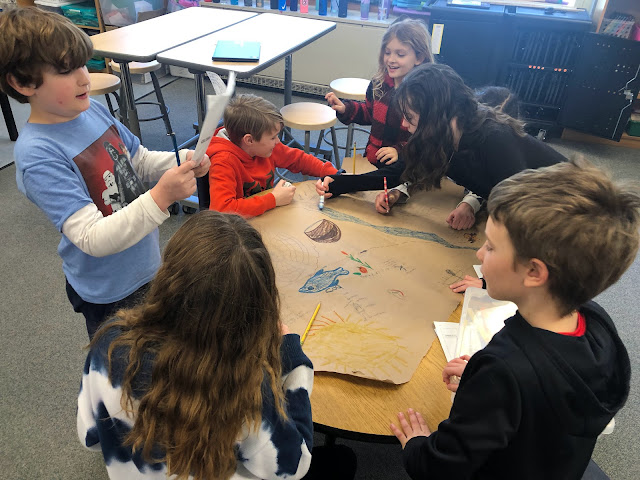In an earlier post, we highlighted the power of visible thinking. Our students LOVE engaging in visible thinking routines - they simply cannot get enough of them. This week, we began our explorations into Native American cultural regions. Specifically, they are investigating how geography affected how and where the earliest people of North America people lived. The enduring idea behind their research is "To understand the present and make plans for the future, we must first understand the past. Where people live matters."
We offered students an opportunity to share out their learning at the mid-point of their explorations and research in an effort to help clarify any misunderstandings about their research, to build upon their existing knowledge, and to share connections they are making as a result of their learning. Using faux buffalo hides (aka brown butcher paper), students drew representations of their learning (much like a sketchnote!) and discussed how people from their cultural regions adapted to the land, resources, and soil that were available to each region. By allowing students to make their thinking visible to one another, they were able to develop a deeper and more meaningful understanding of how the geography of a particular region affects how people live.
This week's guest bloggers share this visible thinking experience. Enjoy.
The buffalo skin activity not only helped me make sense of my own research, but my teammates' were able to make sense of theirs as well. The way one of my teammates explained and illustrated the salmon and totem pole relationship was amazing. It helped me understand that part of the culture in my Native American region. - @Pickle03
It is helpful to see (with drawings) what my classmates are thinking about when we are learning because I get to see other people's perspectives through pictures. - @Lonnie
It is helpful to see how other people think about their learning not just hear about it. To see your classmates show you how they think helps you understand what's going on inside their heads. - @Flash4
A positive experience I had with the buffalo skin activity was when we all talked about what each of us had learned about our Native American cultural regions so far. For example, a teammate and I both wanted to share what we learned about Kachina dolls and so we talked about it first and then decided to make a shelf of Kachina dolls together to show the rest of our group what we had learned. If that isn't a good experience, I don't know what is. - @Dream
The buffalo skin activity helped me make sense of my learning because I love to draw and color and I love to see drawings when I am learning. When I can incorporate them into my work, I understand my learning better. - @G-Money
I think it is helpful when I get to see how other classmates are thinking about their learning because it gives me a better understanding of what we are learning about. Also, I can see how other classmates view things and the different perspectives they have. - @EarthySmurf
A positive experience I had during the buffalo skin activity was seeing what other people's thinking was like. I also like talking with people I don't usually talk with. - @Strawberry
Personally, I liked hearing what my teammates had learned about our Native American cultural region. I also learned some new things because of it and my teammates even learned some new things from me, too. It was a great way to share our research with each other and we all gained a lot more knowledge. - @Kiwi222
In my opinion, to be able to see what other people in my group were thinking was really helpful. I really like working in a group because sometimes I don't pick up every little detail and someone else usually does and shares it with the group. - GoatLover
The buffalo skin experience makes sense and it actually helped me build more knowledge about my Native American cultural region. - @Blocky
The buffalo skin activity was really helpful because it not only helped me make sense of what I was learning, but it helped me look back on what I had learned so that I could remember it better. - Lightning24






.jpg)























